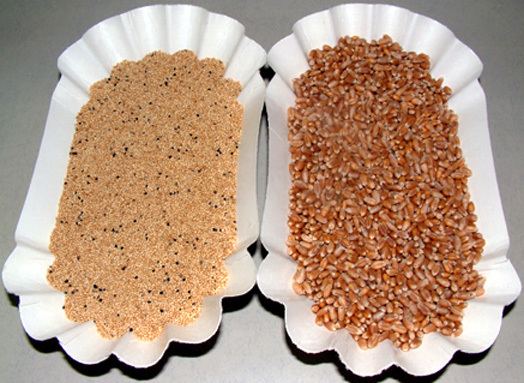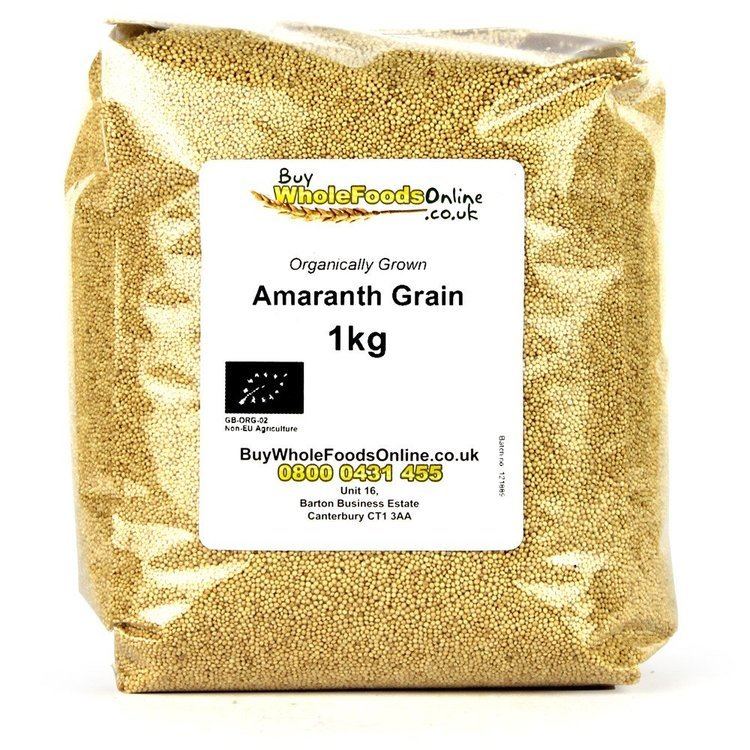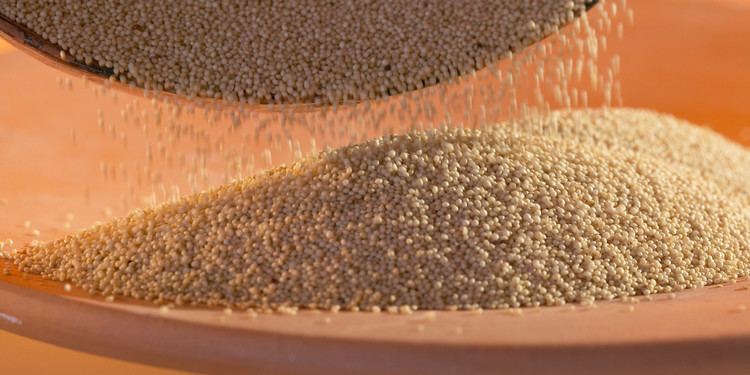Energy 1,554 kJ (371 kcal) Sugars 1.7 g Fat 7 g | Carbohydrates 65 g Dietary fiber 7 g Protein 14 g | |
 | ||
Similar | ||
Amaranth has been cultivated as a grain for 8,000 years. The yield of grain amaranth is comparable to rice or maize. It was a staple food of the Aztecs, and was used as an integral part of Aztec religious ceremonies. The cultivation of amaranth was banned by the conquistadores upon their conquest of the Aztec nation. Because the plant has continued to grow as a weed since that time, its genetic base has been largely maintained. Research on grain amaranth began in the United States in the 1970s. By the end of the 1970s, a few thousand acres were being cultivated. Much of the grain currently grown is sold in health food shops.
Contents
- Harvesting amaranth grain the survival podcast
- Nutritional analysis
- Additional agricultural information
- References
Grain amaranth is also grown as a food crop in limited amounts in Mexico, where it is used to make a candy called alegría (Spanish for joy) at festival times. Amaranth species that are still used as a grain are Amaranthus caudatus, Amaranthus cruentus, and Amaranthus hypochondriacus. The grain is popped and mixed with honey. The popped grain is mixed with melted jaggery in proper proportion to make iron and energy rich “laddus,” a popular food provided at the Mid-day Meal Program in municipal schools.

Amaranth grain can also be used to extract amaranth oil - a particularly valued pressed seed oil with many commercial uses.

Harvesting amaranth grain the survival podcast
Nutritional analysis
As the following table shows, raw grain amaranth has many nutrients.

Raw amaranth grain is inedible to humans and cannot be digested. Thus it has to be prepared and cooked like other grains. Another table below suggests cooked amaranth is a promising source of nutrition comparable to wheat bread—higher in some nutrients and lower in others.

The protein contained in amaranth is of an unusually high quality, according to Educational Concerns For Hunger Organization (ECHO). The actual nutritional value of amaranth as human food is less than would be expected from raw amaranth grain data. According to ECHO, this is due to anti-nutritional factors in raw amaranth grain. Examples of anti-nutritional factors present in amaranth include oxalates, nitrates, saponins and phenolic compounds. Cooking methods such as boiling amaranth in water and then discarding the water may reduce the grain's toxic effects.

Amaranth grain is particularly high in lysine, an amino acid found in low quantities in other grains. Amaranth grain is deficient in essential amino acids such as leucine and threonine – both of which are present in wheat germ. Amaranth grain is free of gluten, which is important for people with gluten intolerance.
The table below presents nutritional values of cooked, edible form of amaranth grain to cooked, edible form of wheat grain as reported by United States Department of Agriculture's National Nutrient Database for Standard Reference, Release 23 (2010).
Additional agricultural information
There are several species and varieties of Amaranth used for vegetables and grains. The Great Plains has seen a surge in this crop from Rodale Farms developed varieties. The virtue of amaranth is that it grows in harsh and lackluster nutrient conditions such as in light soils, much like the grain sorghum. It is a very efficient grain crop.
Amaranthus retroflexus, or "pigweed," is a wild amaranth species in the United States. The name derives from the plant's tendency to sprout where hogs are pasture-fed. Although both its leaves and its seeds are edible, pigweed amaranth has not been cultivated as a food crop.
During the pre-Columbian period, the Aztecs cultivated amaranth as a staple grain crop, according to Kate Seely, a co-founder and the president of the board of Puente. But things changed when the Spanish conquistadors arrived.
In addition to its use as a core food crop, amaranth had been used in a religious context. "Native folks would pop the seeds and mix them with sacrificial human blood," said Seely, who is now based in Oakland, California. "They would form the seeds into sculptures and then eat them in religious ceremonies. This was seen as pagan (by the Spanish), so it was outlawed."
Amaranth crops were seized, fields were burned, and those who tried to grow the plant were punished. According to Noll, the locals replaced their former staple by eating more corn.
But amaranth cultivation did survive in a few isolated pockets. The grain lived on in a traditional treat called alegria (joy), in which popped, whole-grain amaranth is made into bars with honey and sunflower and pumpkin seeds. The bars are often enjoyed during Day of the Dead and other festivals.
